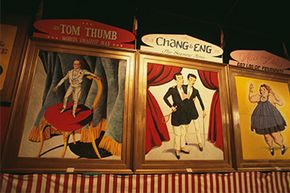Think of it as the reality TV of the 19th century. Conjoined twins, hairy babies, tattooed women, werewolf boys, elastic-skinned men, bearded ladies, two-headed snakes and skeletal men -- all in plain sight, as long as you were willing to pay an entrance fee.
Freak shows were a lucrative draw for circuses traveling around the United States during the mid-19th and early 20th centuries. Putting curiosities on display -- usually in a tent or other structure that would keep people from getting a free look at them -- provided a glimpse of the unusual, and spectators were willing to pay top dollar for a glimpse of unusual-looking people or unusually skilled performers, such as a fire-eater or sword-swallower.
Advertisement
In addition, the collection of oddities served as a publicity machine. Excitement would build as word spread from town to town, and more and more people would clamor to see a three-legged man or other attractions. It was perhaps just as exciting -- if not more so -- than the actual circus itself.
One of the first instances of a freak show occurred in England in the mid-17th century, and centered around Lazarus and Joannes Baptista Colloredo, conjoined twins who were born in 1617. Lazarus was said to be a handsome fellow who happened to have a parasitic twin growing out of his torso. The twin, who breathed on his own, did not eat, open his eyes or speak. The pair made a living by putting their medical oddity on display [source: Royal College of Physicians].
By the mid-19th century, the circus freak show was about to come into its own. English businessman Tom Norman gave it an entrepreneurial spin when he gathered a troupe of people with physical abnormalities and became a freak show showman known as the "Silver King" for his ability to draw in customers. His show included Miss Norma, a woman born without arms or legs, as well as the "World's Ugliest Woman" [source: The University of Sheffield].
Norman's American counterpart, P.T. Barnum, developed a similar idea by first setting up a museum stocked with oddities and by 1871 had become the mastermind behind a freak show that traveled with his circus, "P.T. Barnum's Grand Traveling Museum, Menagerie, Caravan and Hippodrome" [source: Jando].
Within a few years of P.T. Barnum's freak show addition, the concept became commonplace. It was typical to see physical oddities advertised as part of a traveling circus, an idea that remained popular until around World War II, when the prevailing sentiment shifted.
Advertisement
